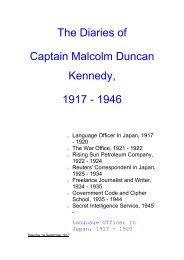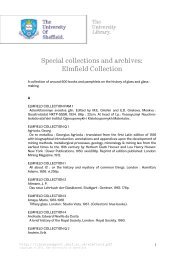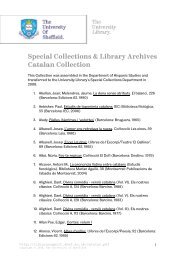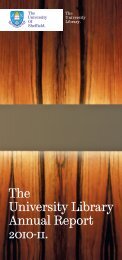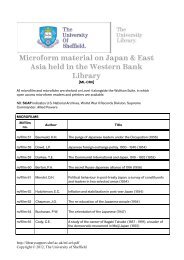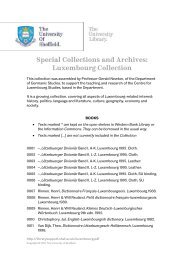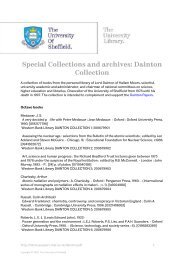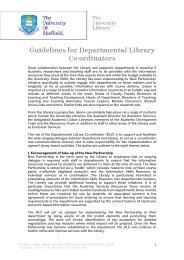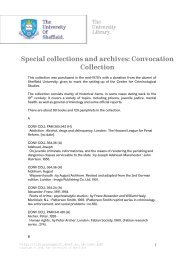The Geoffrey Bullough Collection - Temporary Home Page ...
The Geoffrey Bullough Collection - Temporary Home Page ...
The Geoffrey Bullough Collection - Temporary Home Page ...
Create successful ePaper yourself
Turn your PDF publications into a flip-book with our unique Google optimized e-Paper software.
(Or at least this was the drift of what he said; for though the words I have<br />
repeated were all used in his answer, hundreds more were used likewise.) (p.<br />
123)<br />
And another follows the exchange between M‘cMuckleman and Breadalbane<br />
(see variety # 6 above):<br />
Breadalbane could not help laughing at hearing this gaunt, walking scarecrow<br />
call himself ‗a pretty mon,‘ although aware he used the expression in its<br />
Scotch signification, as denoting strength; and, by silly, he meant weak in body,<br />
not in mind. (p. 214)<br />
7. Other points of interest<br />
Scottish varieties presented in a particularly heavily marked style; also note<br />
much use of (Scottish) idiom and dialect-specific lexis.<br />
Eaton uses many Scottish terms, none of which are glossed or explained in the<br />
text.<br />
Internal inconsistencies in dialect representation evident. For example, note<br />
differing versions (or at least, differing apostrophisation) of ‗you‘re‘ in the<br />
following:<br />
Yer‟e no sic‘ a pretty mon as me, ony day—forbye that ye‟re silly eenow wi‘<br />
that broken pow an‘ arm [emphasis added].<br />
<strong>Bullough</strong> <strong>Collection</strong> No. 146 Jackanapes; Daddy Darwin‟s Dovecot; and the<br />
Story of a Short Life by Mrs J.H. Ewing<br />
1. Publication details<br />
Author: Ewing, J.H.<br />
Author dates: 1841-1885<br />
Title: Jackanapes; Daddy Darwin‟s Dovecot; and the Story of a Short Life<br />
Publication: London: Dent, 1915<br />
First published: 1884<br />
Library reference: 200350742<br />
2. Genre / subgenre<br />
Didactic / moral short story.<br />
3. Brief sypnosis<br />
Child characters and anthropomorphised village animals feature in tales of family<br />
relationships, war, religion, and adventure. Moral / religious commentary follows<br />
(parable style)<br />
4. Overview of varieties / dialects<br />
Clear distinction made between main characters (standard English) and workingclass<br />
peripheral / minor characters who are represented as non-standard speakers.<br />
5. Variety # 1: Nursemaid<br />
5a. Sample of dialect<br />
"You leave off crying this minnit, Miss Jane, or I'll give you right away to that horrid<br />
wicked officer. Jemima! just look out o' the windy, if you please, and see if the Black<br />
Cap'n's a-coming with his horse to carry away Miss Jane."<br />
5b.1 Orthography<br />
Elision o‟; Cap‘n‘s<br />
Respelling windy for window (possibly dialect Lexis rather than Respelling)<br />
Eye dialect minnit<br />
5b.2 Grammar<br />
None noted<br />
http://librarysupport.shef.ac.uk /bullough.pdf<br />
Copyright © 2007, <strong>The</strong> University of Sheffield<br />
49



